Treating WeChat as Growth Flywheel Infrastructure, Not China’s Facebook
- On October 20, 2025
- wechat marketing, wechat strategy
Executive Summary: The Infrastructure Imperative
A crucial strategic misconception prevails among Western enterprises: viewing WeChat (Weixin in mainland China) as merely a local facsimile of Facebook or WhatsApp. This narrow perception results in strategically inadequate investment in China-based infrastructure, cultural mispositioning, and a failure to embed within the nation’s dominant digital ecosystem.
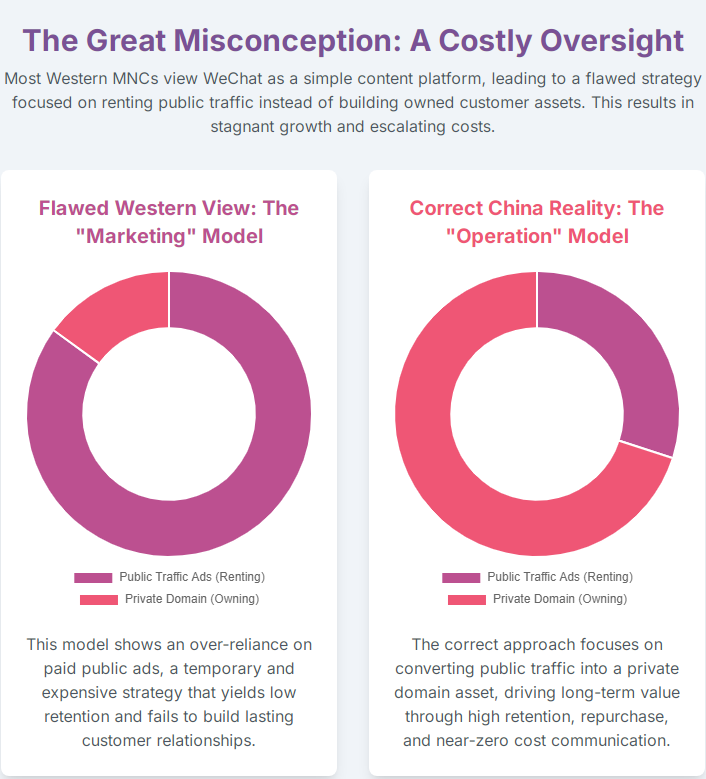
The reality is that WeChat is a “Super App,” an integrated operating system (OS) that combines communication, payment, social networking, and utility, providing Chinese users with a seamless daily function and transactional experience. Success in this ecosystem demands a fundamental shift in mindset: moving from content broadcasting and traditional “Push” marketing to building and owning the high-value asset known as Private Domain Traffic (PDT).
This report analyzes this strategic pivot and presents the core solution: the WeChat Growth Flywheel Strategy. This flywheel is centered on the tightly integrated WeChat Trinity—the foundational digital architecture comprising Official Accounts (OAs), Mini Programs (MPs), and WeChat Work/Pay. Western companies must realize that in China’s digital strategy, WeChat is not optional; it is the essential bedrock.
Part I: The Digital Misconception: Deconstructing the “China’s Facebook” Fallacy (Common Misconception)
1. Strategic Misalignment: The Error of Copy-Pasting Tactics
The most frequent mistake Western multinational corporations (MNCs) make is simply “copy-pasting” global marketing strategies and content into China without true localization. This constitutes a primary strategic misalignment. Western brands often over-rely on their international reputation or brand equity, mistakenly believing that name recognition will automatically translate into trust and engagement among Chinese consumers within the WeChat ecosystem.
This reliance on external reputation rather than localized operation leads directly to underperformance in China’s digital market. WeChat users are discerning digital natives who evaluate brands based on local relevance, service quality, and the integrated experience offered within the WeChat ecosystem, not international accolades or legacy.
Analysis of the Value Perception Gap
Western digital platforms are typically public domain tools focused on content broadcasting and brand awareness—an inherently “Push” marketing model. WeChat, in contrast, is deeply ingrained in daily Chinese life for utility and transaction, reflecting a “Pull” engagement model. When Western brands use WeChat solely for content broadcasting, treating it as another social media channel, they fail to provide the utility, quality service, and integrated experience local users expect. This lack of utility quickly leads to user disengagement and wasted budgets, making the initial faulty judgment—”WeChat is not as effective as Facebook”—a self-fulfilling prophecy. The brand’s goal must therefore shift from optimizing content volume to maximizing service value and utility.
2. The Cultural and Contextual Pitfalls
A failure to deeply understand Chinese culture, extending beyond superficial translation, is a common source of frustration for Western brands on WeChat. For instance, using humor or irreverence that conflicts with Chinese values of harmony and respect, or overemphasizing individualism in a culture that prioritizes community and shared progress, results in significant cultural faux pas.
A deeper misunderstanding lies in the perceived role of WeChat in the customer journey. Many brands see WeChat solely as a publishing channel, ignoring its multi-faceted function across the entire marketing funnel: brand awareness, education, Customer Relationship Management (CRM), conversion, after-sales service, and loyalty/retention.
WeChat is essentially a semi-closed platform , which makes organic discovery less effective than on open Western social networks. Users cannot easily “stumble upon” a brand, necessitating a strategy focused on proactively building relationships and driving followers. This design difference mandates brands focus their strategy on building lasting relationships and providing value, rather than merely broadcasting awareness.
The Barrier of Trust and Regulatory Compliance
Due to WeChat’s semi-closed nature, trust and official verification are critical conversion elements. Chinese consumers view a verified WeChat Official Account as more official and trustworthy than an independent, external website. Failure to embed appropriately via Mini Programs within China’s digital super-app ecosystem or ignoring the rapidly shifting regulatory landscape (e.g., the ban on ICOs resulting in account closures and financial loss) signals a lack of serious, long-term commitment. This perceived instability and non-compliance erode the foundational trust required to build engagement and loyalty , and can carry serious legal and financial consequences. Deploying compliant, local infrastructure is therefore not just an administrative necessity but a prerequisite for establishing consumer trust and unlocking long-term organic growth.
The following table summarizes the strategic dissonance caused by equating WeChat with Western social media platforms.
Strategic Comparison: Western Social Media Platforms vs. WeChat Super App
| Function | Western Social Platform (e.g., Facebook) | WeChat Super App (Weixin) |
| Core Function | Connection / Content Broadcasting | Mobile OS / Utility / Transaction |
| User Flow Goal | External Website/App Link Jumps | Closed-loop, Seamless In-App Experience |
| Brand Strategy Focus | Public Domain Traffic (Rented, Paid Reach) | Private Domain Traffic (Owned Data Asset) |
| Transaction Friction | High (Requires external link jump/separate payment) | Near-Zero (Mini Program eCommerce, Native WeChat Pay) |
| Data Ownership | Controlled by Platform (Third-party data) | Controlled by Brand (First-party data via PDT) |
| Enterprise Tools | Requires Separate CRM/CS Integration | Integrated WeChat Work (Clienteling, SOP, Data Sync) |
Part II: Strategic Repositioning: From Social Channel to Commercial Ecosystem (Consequences/Correct Understanding)
3. Defining the Super App: WeChat as China’s Digital Hub
WeChat has become the central nexus of digital life in China, boasting over 1.3 billion monthly active users (MAU). It is more than a chat tool; it is an “app for everything,” integrating messaging, social networking, gaming, shopping, news, and mobile payment. This broad integration creates powerful user “stickiness,” with users spending an average of over 90 minutes per day on the platform.
Architecturally, WeChat transcends the function of a standard application. It operates more like a mobile operating system (OS), hosting millions of “Official Accounts” and “Mini Programs,” which function as “apps within an app”. Due to its growing power and comprehensiveness, the fluency of WeChat itself often matters more to Chinese users than the underlying mobile OS (iOS or Android).
3.1. The Commercial Cornerstone: The WeChat Trinity Architecture
WeChat’s pervasiveness and commercial success are built upon the synergy of three core elements: Official Accounts (OA), Mini Programs (MP), and WeChat Pay/WeChat Work (WeCom). These three pillars form the integrated infrastructure for brands to connect, convert, and retain customers.
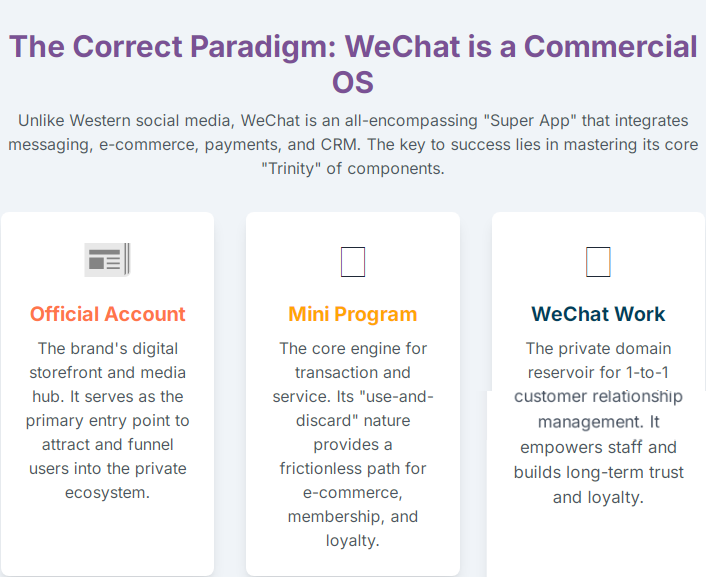
- Official Account (OA): Serves as the brand’s content shop window and initial engagement tool. It expanded WeChat’s capabilities beyond pure messaging into a genuine content ecosystem.
- Mini Program (MP): Independent applications hosted within the WeChat platform that users can access instantly without downloading. The Mini Program is the crucial conversion engine, hosting functions like e-commerce, service booking, lead generation, and utility tools.
- WeChat Work (WeCom): Tencent’s enterprise tool designed to enable sales and service teams to connect directly, compliantly, and standardly with individual WeChat users, serving as the backbone for clienteling and CRM.
The Standard of Near-Zero Friction
A defining characteristic of the WeChat ecosystem is its pursuit of a frictionless user experience. The native integration of Mini Programs with WeChat Pay offers Chinese users a unified “one-click payment” experience that has become the default expectation for digital transactions. While buying a movie ticket or hailing a taxi might require different native apps in the West, these tasks are typically handled efficiently by Mini Programs in China because they feature baked-in, frictionless payment functionality.
Western brands that still rely on credit card payment gateways, or require users to jump to external links or separate apps for authentication, introduce immense friction. This stands in stark contrast to the Chinese user’s expectation of speed and convenience, resulting in high conversion abandonment rates. Native WeChat Pay integration is therefore a prerequisite for achieving high conversion rates for international businesses entering China.
4. The Strategic Imperative: Mastering Private Domain Traffic (PDT)
The Private Domain Traffic (PDT) strategy involves funnelling customer communication and interaction into brand-owned channels—such as Official Accounts, Mini Programs, and community groups—where the brand retains 100% ownership and control over user data and communication.
This strategy is a direct response to the rising costs of customer acquisition (CAC) and traffic saturation on public platforms like Taobao and Douyin. The concept of PDT has rapidly gained traction in marketing circles because it has been proven to acquire more precise users and improve retention at a lower long-term cost.
First-Party Data as a Definitive Business Asset
As e-commerce growth slows and market competition increases in China, reliance on paid advertising on public platforms is becoming expensive and subject to volatile algorithms. PDT builds a digital environment directly controlled by the brand, transforming transient visitors into measurable, brand-owned customer assets. By controlling the communication frequency and content, brands can focus on driving high repurchase rates and increasing customer lifetime value (LTV).
If Western enterprises continue to treat WeChat merely as “China’s Facebook” for content broadcasting, they forfeit the strategic opportunity to accumulate this irreplaceable first-party data asset. Executive investment in WeChat must be redefined: it is no longer a marketing expense, but a strategic capital investment in data infrastructure and customer asset accumulation, whose success should be measured by metrics like retention and LTV.
The WeChat Trinity: Roles and Metrics in the Flywheel
| Component | Primary Flywheel Role | Key Functionality | Core Success Metrics |
| Official Account (OA) | Brand Awareness, Content Hub, Lead Nurturing | Content Publishing, Automated Welcome Messages, Mini Program Linking | Follower Growth Rate, Article Read Rates, Content Conversion Rates |
| Mini Program (MP) | Conversion, Service, Loyalty, Utility | E-commerce Storefront, Event Registration, Membership/Gamification | Retail Conversion Rates (up to 25%), Daily Active Users (DAU), Repeat Purchase Rate |
| WeChat Work (WeCom) | Customer Retention, Clienteling, Enterprise Management | 1-to-1 Chat, Data Tagging, SOP Compliance, Customer Turnover Feature | Employee Adoption Rate, Customer Satisfaction (CSAT), Relationship Duration |
Part III: The WeChat Growth Flywheel: Architecting the Closed-Loop Strategy (Value Enhancement)
5. Driving the Flywheel: The Public-to-Private Funnel
The Offline-to-Online (O2O) connection, primarily facilitated by QR codes, is the key mechanism for routing physical store visitors into the digital Private Domain Pool. Many international brands successfully utilize public platforms (like Xiaohongshu and Douyin) for broad brand exposure, then rigorously funnel this traffic into their WeChat Private Domain Pool. For instance, the Australian health brand Swisse achieved growth through a highly unified “Official Account + Mini-Program + WeChat Work + Community” matrix, supported by public domain channels.
Onboarding optimization is crucial for conversion. While historical default welcome messages for Official Accounts might have simply been “Thank you for following” , brands can now fully customize the welcome message to immediately offer new followers an incentive to join membership, enter a community group, or seek direct consultation. Swisse, for example, uses automated welcome messages on its Official Account to guide users to membership and connect with a nutrition consultant.
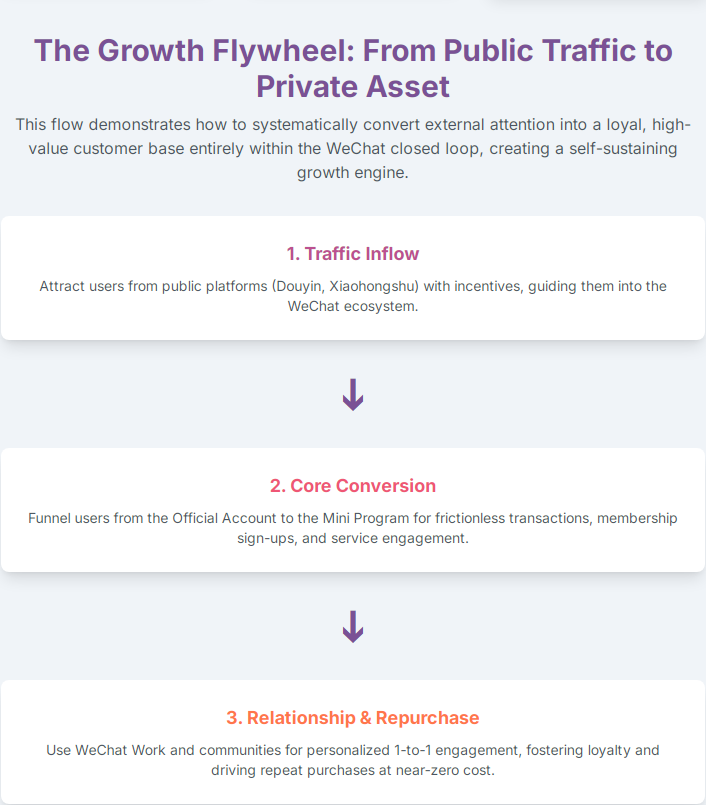
The Dual-Ecosystem Funnel Strategy
Acquiring new customers solely on WeChat is inefficient due to its semi-closed nature and limited organic discovery. The most sophisticated strategy is therefore a Dual-Ecosystem Funnel: leveraging the high-reach capabilities of public platforms (like Douyin, Xiaohongshu) to capture mass attention and trending content , and then rigorously and incentivizedly converting that high-cost public traffic into the low-cost, high-LTV WeChat private domain environment. This requires clear, incentivized funnelling mechanics, such as offering a lucky draw or an exclusive report to drive users toward a Mini Program or Official Account for subsequent conversion and retention.
The operational logic of this strategy is the balance of investment: Public traffic pays for attention, while Private traffic (WeChat) pays for conversion and customer retention.
6. Conversion and Service: The Mini Program Advantage
Mini Programs, as instant-access applications within the WeChat ecosystem, are designed for specific tasks, bypassing the friction of separate download and installation. This dramatically reduces friction, and conversion rates achieved through Mini Programs in the retail sector can be as high as 25%. For example, BMW leveraged its WeChat Mini Program to convert 38% of engaged users into dealership visits. Western brands like Nike use Mini Programs for limited-edition sneaker reservations, product personalization, and in-store event bookings, enhancing loyalty through interaction and exclusivity.
For high-end and luxury brands, such as Lancôme, the Mini Program delivers an elevated user experience, boosting engagement among existing clients and driving sales. Many luxury jewellers and brands are choosing the Mini Program as their exclusive e-commerce channel in China to gain total control over traffic, customer data, and the customer experience. Lululemon’s “Hot Sweat Life” Mini Program, for example, built a community-driven loyalty model by blending online shopping, fitness event registration, and content sharing into a single social hub.
The Bi-Directional Reliance of Mini Programs and Official Accounts
Seamless integration between the Official Account (OA) and the Mini Program (MP) powers the closed loop. The OA drives traffic towards the MP, which focuses on transactional conversion, via content articles and menu links. More strategically, recent WeChat updates allow the MP (the point of transaction) to guide users back to the OA (the CRM/nurturing center) via a one-click follow button. This bi-directional flow ensures that transactional customers are converted into long-term engaged followers, sustaining the flywheel and maximizing the value of the acquired data asset.
Mini Programs are thus not just mobile storefronts; they are integrated data and conversion tools. To ensure focus and avoid interrupting the user’s normal flow , Mini Programs must strictly adhere to WeChat platform rules against mandatory jumps to external links, which can result in feature limitations or even permanent removal.
7. Operationalizing Loyalty: Customer Maintenance via WeChat Work
WeChat Work (WeCom) is indispensable for MNCs seeking to standardize customer service, retain customers, and scale clienteling in China.
The Key Advantage of WeChat Work is Interoperability. It connects employee corporate accounts directly with the customer’s personal WeChat account. This allows Sales Associates (SAs) to manage client relationships through a centralized, compliant interface, pushing tailored content (e.g., WeCom Moments, Mini Programs, or Official Account articles) based on client interests. WeChat Work also provides critical safety and compliance features, such as message archiving, watermarking to prevent data leakage, and the customer turnover feature for compliantly transferring clients to new staff (mitigating key person risk).
Scaling Relational Service
China’s relationship-driven market environment demands highly personalized customer service. WeChat Work enables multinational companies to scale this human-centric service without sacrificing compliance or data control. By providing SAs with centralized data and controlled communication tools, WeChat Work transforms the personal efforts of sales staff into a measurable corporate function.
This structured system supports the cultivation of Key Opinion Consumers (KOCs). KOCs are everyday users whose recommendations carry higher credibility within their social circles and private groups. By incentivizing KOCs to share product information and invite friends to community groups, brands can acquire social traffic and new customers through trusted word-of-mouth marketing at a lower cost. WeChat Work is the crucial link connecting the conversion strategy (MP) with the retention strategy (PDT communities), ensuring that the first-party data asset is continuously enriched and utilized through personalized human interactions.
Part IV: Data, Compliance, and Automation: Solidifying the Asset (Sustained Value)
8. Data Architecture and Regulatory Compliance
WeChat CRM solutions (Social CRM, sCRM) are essential for integrating customer behavioral data from the WeChat ecosystem with global enterprise CRM systems like Salesforce.
However, China’s local data regulations, specifically the Personal Information Protection Law (PIPL), pose a compliance challenge more formidable than the GDPR in the West regarding cross-border data transfer and processing. This is particularly acute for luxury brands serving global Chinese clientele who expect consistent personalization across different markets. Localized sCRM solutions (such as JINGsocial) and specialized Salesforce China integrations (like CXG) are therefore necessary to bridge this compliance gap and achieve seamless data synchronization.
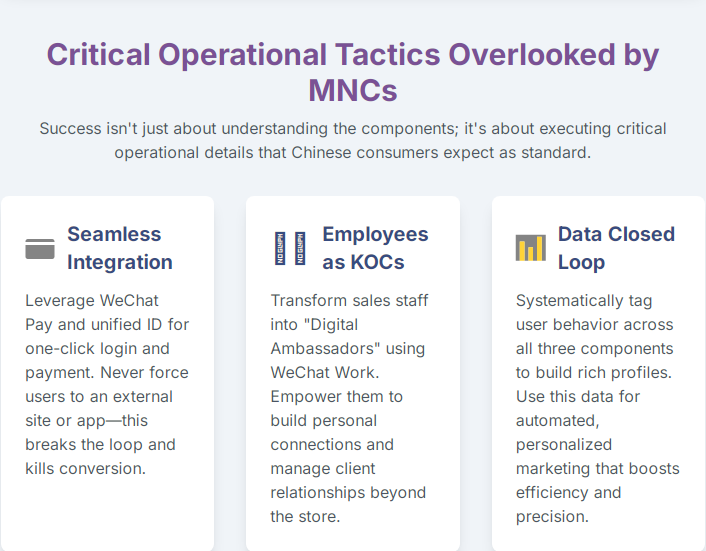
PIPL as a Driver of Data Strategy
China’s strict PIPL regulations, combined with the immense strategic value of WeChat private domain data assets , necessitate a local-first data architecture. The challenge is not just connecting systems but executing strategic tasks such as ID mapping (linking a customer’s identity across different datasets/platforms to unify the profile) and securely syncing data to support the high degree of personalization demanded by high-value customers.
Regulatory compliance is thus not an IT department burden but a strategic force driving investment complexity and the adoption of sophisticated sCRM and integration technologies. Failure to compliantly transfer data or centralize WeChat behavioral data negates the entire value of PDT, inhibits personalized experiences, and exposes the brand to legal risk.
9. Scalable Automation and Personalization
WeChat, as a closed-loop CRM platform , is designed to track user behavior, build relationships, and nurture long-term loyalty. Marketing automation technologies allow brands to deploy AI customer service, precisely segment users, and push personalized notifications (e.g., restock alerts, birthday wishes, or targeted promotions).
This personalization strategy respects the user-centric nature of the WeChat platform. Brand Subscription Account content is sequestered in a separate “Subscriptions” folder, allowing users to choose when to engage with brand content, reinforcing the “Pull” engagement model. Advanced sCRM platforms (like JINGsocial and Quick Audience) enable automated user journey mapping and deployment, as well as precise, cross-media content pushes.
Automation that Supports Authentic Interaction
While automation is vital for scale, Chinese consumers highly value the social and human element of the platform. The purpose of automation is therefore to augment human interaction, ensuring that personalized and highly relevant messages reach the correct segment at the optimal time. This targeted pushing avoids “message bombardment” and preserves the perceived human connection established through WeChat Work clienteling.
The success of the automation layer is entirely dependent on the quality and depth of the first-party data collected via Mini Program and WeChat Work interactions. Automation allows brands to scale the strategic mandate of “serving, not just selling”.
Private Domain Traffic (PDT) Value Proposition Metrics Comparison
| Metric | Public Domain Traffic (e.g., Tmall/Douyin Ads) | Private Domain Traffic (WeChat Ecosystem) | Strategic Implication |
| Customer Acquisition Cost (CAC) | High and continuously rising (algorithm dependent) | Low long-term cost (Brand-owned asset) | Efficiency and scalability of growth |
| Conversion Rate (CR) | Standard (Requires external jumps/complex funnel) | Very High (Up to 25% in retail; 63% higher than open platforms) | Direct Return on Investment (ROI); frictionless purchase path |
| Customer Lifetime Value (LTV) | Variable, lower dependency | High, focused on retention and repeat purchase | Sustainable revenue growth; accumulation of customer asset |
| Data Control | Minimal (Third-party platform data) | Complete (First-party data asset) | Personalization, regulatory compliance (PIPL), strategic asset accumulation |
Conclusion: The Strategic Blueprint for Sustained Growth in China
The analysis in this report clearly demonstrates that Western enterprises must cease treating WeChat as a tactical social media channel. WeChat is a critical business operating system, and its core infrastructure—the WeChat Trinity of OA, MP, and WeCom/Pay—must be invested in as a central strategy for China market entry.
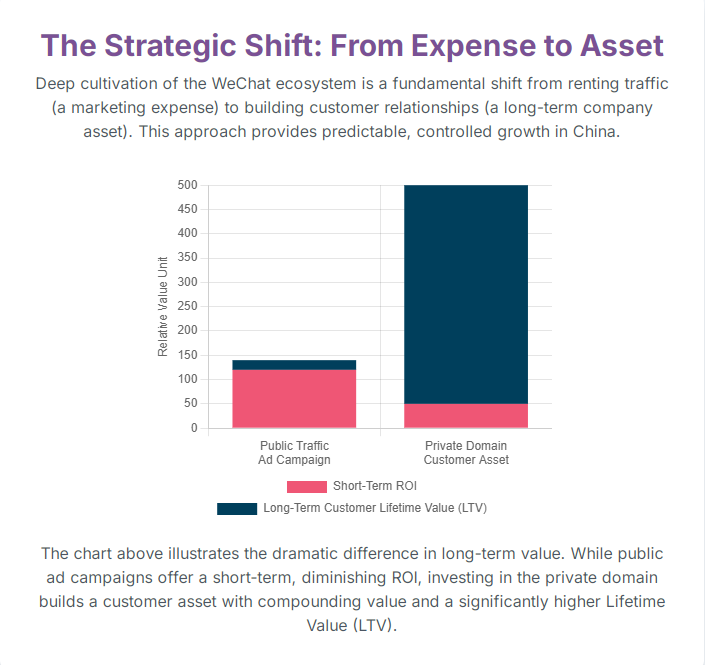
The true competitive edge in the Chinese market lies in the controlled accumulation and compliant utilization of Private Domain Traffic (PDT). A successful strategy requires operational excellence across several layers:
- Cultural and Utility Alignment: The strategy must pivot from “Push” to “Pull,” prioritizing service and utility functions delivered via Mini Programs and WeChat Work over mere content broadcasting.
- Infrastructure Seamlessness: Investment in Mini Programs is mandatory, and their native, frictionless integration with WeChat Pay must be ensured to meet the Chinese consumer’s expectation for instantaneous, convenient transactions.
- People and Technology Synergy: WeChat Work (WeCom) is the key to operationalizing the retention strategy, empowering sales staff with standardized, compliant tools to transform high-touch clienteling into a scalable corporate asset and supporting low-cost, high-trust word-of-mouth marketing via KOCs.
- Data Asset and Compliance: PDT data must be treated as a high-value, first-party data asset. Investing in localized sCRM solutions and data integration technology is required to ensure that customer behavioral data is compliantly collected, tagged, and synchronized, enabling advanced personalization while adhering to strict regulatory requirements like PIPL.
Ultimately, the successful strategic roadmap involves shifting resource investment away from expensive public advertising toward building and maintaining this high-value, frictionless, closed-loop digital environment. Through this infrastructure-first approach, Western brands can cultivate long-term customer loyalty, achieve superior customer lifetime value, and secure continuous growth in the world’s most dynamic digital market.

 Unlock 2025's China Digital Marketing Mastery!
Unlock 2025's China Digital Marketing Mastery!